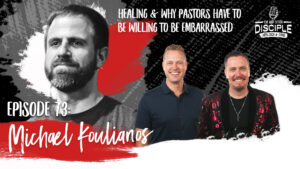The state of our faith in our nation is in rapid decline. This may surprise you, but the majority of people in 2022, 63%, still self-identify with the Christian faith. You would think with that high percentage that collectively, our reach and influence would extend across every spectrum, but sadly, we seem content to remain silent on the margins. While 63% of people is still a significant majority, over the past decade, that number has slid down from 74%. 11% may not sound too extreme, but that represents nearly 35 million fewer people in a decade who no longer identify with Jesus being their Savior. Pew Research has done some future charts to show that if things remain similar, those with the Christian faith will no longer be the majority between 2050-2070. That is not far off; literally, one or two generations away.
Over the past few months, I’ve interviewed 12 lead pastors in Omaha, NE, about the state of evangelism in their churches. I’ve done this in partnership with a group called Within Reach, a group of pastors working together to reach the city of Omaha for Jesus. It’s truly a remarkable organization, and I’m proud to play a small part in it.
Thom Rainer, founder, and CEO of Church Answers, believes we are now living through the death of evangelism in the North American church. His company has been tracking data in the church since 1996. They’ve looked at the primary purposes of the church, like evangelism, discipleship, ministry, worship, fellowship, and prayer. As they’ve analyzed the data over 25+ years, they have noticed that the “evangelism number almost looks like nothing but a downhill rollercoaster.”
People in the church are concerned about this decline, but the activity is still dropping. He says those concerned about it “don’t know what to do about it.”
To summarize, we are aware of the problem of the state of evangelism, but we are not clear on the answer.
I grew up on the tail end of what’s known as the “Evangelism Explosion” model. Of course, some will knock this model, and our world has changed since this method became popular. But can I be honest with you? Any model, even if it’s ineffective, is better than no model at all.
These interviews have opened my eyes to what’s happening in the church world regarding evangelism. In addition, I’ve seen common trends in obstacles the church faces that emerge from these conversations. Hopefully, by seeing these trends, we can come up with an effective strategy to combat these obstacles.
Reigniting Faith and Outreach in an Era of Decline
Listed in the blog are not just five obstacles, but 26 ideas and resources that we can use to help our churches in our pursuit to bring new life and energy to the state of evangelism.
- People are too busy.
When I ask someone how they are doing, one of the most common responses is, “Busy.” That’s crazy!
Corrie Ten Boom once said, “It the devil can’t make you sin, he’ll make you busy.”
The number one obstacle that showed up in my interviews was the overall busyness of our culture today. It could be a variety of reasons that people are busy:
- Choosing our career and working long hours in our pursuit of the American Dream
- Idolizing their children’s sports or activities (this specific example came up more than any others in my interviews)
- Choosing entertainment and social media over their faith
- We want to please other people, and so we say “yes” to things we ought to say “no” to
Another possible reason is that people don’t intentionally think about how they spend their time. I actually believe people are far less busy than they think they are. The problem is that they choose to spend their time on things that don’t bring fulfillment.
As churches, we must preach against and provide resources that bring to light the evil of the rushed, hurried, and frantic pace that many live. It’s also crucial that we help people spend their time wisely. Anxiety, worry, stress, loneliness, and depression are all trending in the opposite direction. When will we learn that just filling a calendar does not equal a fulfilling life?
Recommended ideas and resources:
- John Mark Comer: The Ruthless Elimination of Hurry: Comer masterfully paints how busy and hurried we are as a society and gives practical tips and tools on how we can be more as Christ has called us to be. Consider using this in your small groups through a website like RightNow Media.
- Being Challenge: A 40-Day Challenge to Be Like Jesus: Only one person ever existed in a perfect relationship with God, and His name is Jesus. This book will introduce you to five keystone habits that Jesus practiced to “be” with God, giving you specific challenges to help you along the way.
- Carey Nieuwhof: At Your Best: How to Get Time, Energy, and Priorities Working in Your Favor: Nieuwhof’s book (and my preferred option, his online course) really helped me understand the value of calendar blocking and doing what I’m best at when I’m at my best. Consider getting access to this online course or book for your entire staff.
- Provide a calendar worksheet to pass out to those in your church to see how much time and margin they actually have. Email us at hello@redletterchallenge.com, and we’d be happy to send you a sheet.
- Individualism has created fewer friends.
The rise of technology and smartphones present us with more opportunities than ever to connect with others. The result? North Americans have never statistically been as disconnected as we are right now. And the disconnection is resulting in more loneliness than ever in our nation. The younger you are, likely the lonelier you feel.
Here’s the thing about statistics. Those numbers have real people behind them.
We shouldn’t be shocked at the rise in loneliness because, since our nation’s existence, we have celebrated individualism. But, while individualism has some positive elements to it, it becomes the opposite of the life that Jesus calls us to live when lived out to its fullest.
Individualism is perhaps most seen in the following slogans of our day:
- You be you.
- Find yourself.
- Follow your heart.
- Have it your way.
When we are taught to pursue our interests and heart and go with our feelings, it often leads to very lonely lives. Many spend their “off” hours binge-watching Netflix, scrolling through social media feeds, planning and going on vacations, and trying to fill every waking hour with entertainment options to avoid boredom. Most Americans don’t know most of their neighbors—and they barely talk to the ones they do know. It’s tempting after a long day of work to drive home, close the garage, and tune the rest of the world out.
Left to our own devices, we will often choose what is most comfortable at the moment. And what is most comfortable is typically the comforts of your own home.
Americans have fewer friends than ever. In just 30 years, we’ve seen the number of friends rapidly decrease. In 1990, 33% of Americans reported having ten or more close friends. Now, it’s lower than 13%. Similarly, in 1990, 73% of people had more than three close friends. Currently, only 51% do. Our friendship circles are getting smaller. And, if our goal is to tell the Good News of Jesus to others, and the most winsome strategy is to be friends, and in a relationship with another person, then it’s no wonder our evangelism numbers are declining.
If our people are suffering from this, so are pastors. Sometimes I wonder if we struggle with this more than the average person. As a pastor, it is so easy for me to surround myself naturally in a Christian bubble. Without intentionality, I could go a long time without having a significant relationship with someone who doesn’t know Jesus. That’s comfortable for me. But it’s not right.
If we want our evangelism efforts to be strong in churches, we must push people towards relationships and out of individualism.
Recommended ideas and resources:
- BLESS: 5 Everyday Ways to Love Your Neighbor and Change the World by Dave Ferguson: An excellent, practical, simple-to-read, and implement book on how to be better and more intentional neighbors.
- Give your church members some money to throw a block party. Especially in the urban areas, one of the number one needs that those in the community wanted were block parties.
- Small Groups: Go all-in on small groups at your church. Did you know that we’ve worked with more than 1000 churches to help grow their small groups? I’ve created a FREE, super-simple, easily-doable 5-step guide to grow your small groups. Find it here.
- Challenge each church member to start a new project with at least 3-5 new people in the coming year. Provide a list of project ideas to help them.
- For those who are surrounded by only Christian friends, ask them to join a sports team, club, or business group.
- Churches are too inward-focused.
Not all of the obstacles of evangelism’s root problems are because of our people. Some are because of our leadership. In my interviews, many lead pastors admitted that they offer far too much inside the church walls. This left no time to do anything outside of the church.
I can relate.
I had just planted a church in 2011, and my core group was extremely solid, loyal, and committed to the inward-focused aspects of the church. They were generous, showed up way more than the national average for weekly worship, and volunteered to help with things inside the church. But, I noticed any attempt to push them outside the church walls, specifically serving others in the community or inviting their friends to come to church, seemed to fall on deaf ears.
I had no other ideas for mobilizing an entire church, so I challenged the church to do what Jesus said. I took 40 random commands of Jesus, wrote blogs to go with them, and challenged them to do what Jesus said literally. Over time, this idea of hearing and doing the words of Jesus would develop into Red Letter Challenge.
When you look back at the words of Jesus, over and over again, Jesus calls us to go. To make disciples. To preach the Good News. To share our faith. To be a worker in the field. Even Jesus’s final words before His ascension describe His followers as witnesses to the ends of the earth. Yet, the structure of the churches that many of us have either inherited from previous generations, or built ourselves, are primarily centered around a model that takes most of its time, energy, and priorities in caring for its own.
There is nothing inherently wrong with building facilities and having excellent worship services. But, when a church becomes known for only what happens inside its four walls, we have a severe problem. To be a pastor and focus your time, energy, and priorities on those who already attend inside the four walls of your church may be comfortable for you, but it’s not right. To extend beyond the four walls of the church and to seek those who are lost, sometimes even at the expense of those who are found, is highly uncomfortable, yet this is what God calls us to do.
Exploring Evangelism Ideas and Resources:
- Red Letter Challenge: In the bestselling Red Letter Challenge, readers will understand how important it is to be a disciple and learn five targets for how to follow Jesus. The targets include challenges that will get the people into the community and world to make a difference for others.
- Look at numbers in your church to determine what percentage of staff hours, budget, and volunteering goes towards things inside the church vs. outside of the church.
- Link up with non-profit organizations in the community that will provide opportunities not only to give financially but to volunteer or serve regularly. Put these non-profit organizations before your people periodically and share testimonies of those whose lives are being impacted.
- Serving Challenge: Coming out in the Fall of 2023, this 40-day challenge, more than any other, will get your people outside of the walls of your church to serve like Jesus. Join our newest 40-day Serving Challenge.
- Do a BIG push as an organization to have everyone in your church volunteer or serve in the community for a week. Here’s a great model that Within Reach in Omaha, NE, uses called CityServe.
- Many churches lack a strategy for evangelism.
Nearly every pastor I spoke with believed that evangelism is crucial. Many said it was one of the most vital things that they do. But pastors were truly split on whether or not they actually had an evangelism strategy or plan.
I believe the church has a problem indicative of most Christians in North America. I do not think we have an intention problem in our nation regarding living out the call to follow Jesus. But, while we don’t have an intention problem, we do have a planning problem. To want something but not create a plan, strategy, or system to accomplish the desire would be extremely foolish. And yet, this is the reality for many churches. They desire to excel in evangelism but have no clear system, playbook, strategy, or measurables. It’s a confusing message.
Intention without direction always leads to confusion.
If we say something is essential yet have no strategy for it, it’s not really that important. So, pastor, how would you characterize your church’s plan for evangelism? How would the rest of your church describe how they fit into the plan?
In the complex world in which we live, each church ought to have its own unique strategy. So rather than doubling down and thinking that your evangelism strategy should fit every church, a healthier attitude recognizes every church will look different.
In the churches with an evangelism plan, I was amazed at the diversity of strategies found in the same city. I was intrigued and impressed by the various ways God can work through each church. Here are a few examples:
- A suburban church multisite features a uniquely gifted, once-in-a-generation communicator and a charismatic leader. Their approach to evangelism is to train those who attend to invite others to attend the weekend services. Then, when a guest does show up, they will hear the Gospel presentation every week and be given a chance to respond. This strategy is wrapped around the weekend service, and though it may appear to be old-school, this church happens to be a part of the largest church in our nation.
- Another church heavily focuses on pre-conversion efforts. In other words, they focus on deconstructing some cultural assumptions or beliefs that people may have about Christians. Their evangelism strategy, then, is to use their weekend services to train their people how to engage in apologetics and, additionally, how to use their own homes in their neighborhoods to bring everyday people into groups. Their services are less seeker-friendly and almost more of an apologetics training ground that helps foster groups in every neighborhood they live.
- An urban church has a pastor with a gift and desire to start kingdom-minded businesses, especially amongst the black community. So, rather than the traditional model, this church focuses a lot of its evangelism efforts on bringing good to the community through starting new businesses. As they launch a business incubator school and entrepreneur training, they are then allowed to share the Gospel of Jesus with others.
- In 2010, a suburban church started a program called OneLife. The pastor wanted the people in his congregation to see that every person mattered. So they began asking the people in the church to nominate their neighbors, friends, or those in need around them. They would choose one person each week to bless with a special offering. They would then give that offering to the church member to present to their neighbor or friend in need. As they became generous and caring of others, it allowed them to share the Good News of Jesus with those they’ve helped. Many who had been helped would eventually become a part of this church and are now helping others.
Those are just a few of the many different evangelism ideas and examples that came from my conversations. The point isn’t that your church should match a, b, c, or d perfectly. Instead, your church needs to have an evangelism plan in place. Additionally, in all of the examples above, the strategy came out of the heart, the gifting’s, and the experiences of the lead pastor.
Recommended ideas and resources:
- Write out or print out your evangelism plan (if already written). Ask the leadership of the staff what the plan is for evangelism at your church and record their answers. This will likely show you how straightforward (or not) your strategy is.
- If you are the lead pastor, identify what you are passionate about and how you came to faith or grew in your faith. Is there a model or strategy that you can employ that can be based on your experience?
- Choose to interview a few local pastors to hear their evangelism ideas and strategy. Hearing theirs can help inform yours.
- Many who attend church don’t believe it’s their personal responsibility.
One pastor I interviewed expressed his desire that people would feel the opportunity and the personal responsibility that each of them holds when it comes to evangelism ideas. There is nothing quite like bringing a friend to know Jesus; we all want to experience that.
According to a recent Barna study, Christians increasingly believe that evangelism is the local church’s job, not personal responsibility. This number has nearly tripled in 25 years, from 10% in 1993 to 29% in 2018. Additionally, if you look at actions, only 52% of practicing Christians have shared their faith at least once with someone in the last year. With fewer and fewer people evangelizing combined with shrinking circles of friends, it’s time that churches rethink evangelism.
In the previous obstacle, we talked about the importance of having a strategy. Let’s get more specific about what I noticed in the growing churches. The growing churches employed an evangelism strategy with both a corporate solution and an individual responsibility.
Even though the evangelism strategy may be uniquely tied to the lead pastor’s heart, giftings, or experiences, each of the strategies employed their people to be a part of it. Your evangelism strategy needs to include every single person in your church. They need to clearly understand how they fit and the role they uniquely play in it.
For this, I turn to Rick Warren’s four truths about evangelism:
1. Each of us needs to accept personal responsibility.
We are God’s plan, and there is no Plan B. We are His ambassadors, and He is making His appeal through us. People need to understand that they don’t need to have a doctoral thesis on the Bible before they can start sharing the Good News. Jesus asks us to be His witnesses.
2. Develop a personal relationship.
People don’t care how much you know until they know how much you care. So while a variety of evangelism strategies can and should take place today, everyone agrees that being in an honest, caring relationship with someone else can only help bring Jesus to someone’s life.
3. Share your personal story.
Evangelism is less about telling other people what is wrong with them; instead, it’s telling them what has happened to you. So when I challenge people to talk to someone else about Jesus, these are the two questions I encourage them to answer:
- What has God done for you?
- What difference has God made in your life?
4. Give a personal invitation.
The church has much room to grow in helping people give an invitation not just to a church service but how to follow Jesus. Some evangelism models are still very tied to attending a church service, but even better is when we can begin training every person in our church to invite someone to believe in and follow Jesus.
Recommended ideas and resources:
- Lead a weekend sermon series on the importance of evangelism, stressing the personal responsibility of every church member.
- Host an evangelism workshop, training, or small group series at your church.
- Host a role-playing evangelism night. The more we practice scenarios and dialogue about our experience, the better we will become. Use the role-playing guide here if you’d like.
- Challenge each person in your church to write out their testimony. Answer the questions “What has God done for you?” and “What difference has God made in your life?”
- Visit www.iamsecond.com to watch some incredible testimonies to help inspire others to write their own.
- One church employed a “My4” strategy. They would give people a card with four blanks. On each of the blanks, people would write the name of someone they would commit not only to pray for but also look for opportunities to share the Gospel within their lives.
- Highlight someone in your church who has a gift evangelistically and ask this person to share more about how they do what they do.
- Share regular stories publicly in your church service about someone sharing Jesus with a friend and its impact.
- Utilize the important people who have helped someone else come to faith more in the newly converted person’s baptism celebration at church.
I hope that by seeing the obstacles in front of us that we can now more effectively build out a plan. Jesus is the hope of the world. That’s why I’m not nervous, even if every statistic I see trends in the wrong direction. He wins. And those that are in Christ Jesus win. Have faith. Stand strong. But let’s not just sit idly by.
Let’s share the Good News of Jesus with the world, one person at a time.
Then, once we get them into our churches, that’s where discipleship comes into play. For more on that, see this blog.
Blessings!
Zach Zehnder




